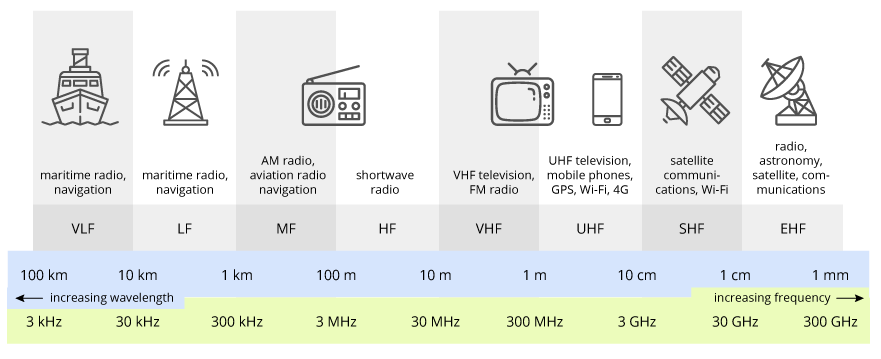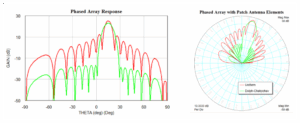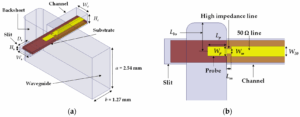Understanding RF Bands and Frequencies
Radio Frequency (RF) bands refer to the range of electromagnetic frequencies used for transmitting data wirelessly. This spectrum is crucial in various communication technologies, including radio, television, cell phones, and wireless networks. The RF spectrum is measured in hertz (Hz), and it spans from very low frequencies in the kilohertz (kHz) range to ultra-high frequencies in the gigahertz (GHz) range. The understanding of RF bands is essential for anyone involved in wireless communications, whether for personal use or in professional settings.
Each RF band has unique characteristics that make it suitable for specific applications. For instance, lower frequencies tend to have longer wavelengths, allowing them to travel further and penetrate obstacles like buildings and trees. Conversely, higher frequencies can carry more data but have shorter ranges and can be obstructed more easily. This fundamental distinction affects how different technologies are designed and deployed, impacting everything from mobile networks to satellite communications.
In addition to frequency, RF bands are classified according to their wavelength. The basic relationship between frequency and wavelength is inversely proportional; as frequency increases, the wavelength decreases. Understanding this relationship helps in grasping how signals propagate and how various factors, like interference and attenuation, can affect signal quality over distance. By familiarizing yourself with these concepts, you’ll build a solid foundation for exploring the specific types of RF bands and their applications.

Types of RF Bands
RF bands are categorized into several classifications based on their frequency ranges, each serving different purposes and applications. The most commonly referenced bands include Very High Frequency (VHF), Ultra High Frequency (UHF), and Super High Frequency (SHF). VHF ranges from 30 MHz to 300 MHz and is often used for FM radio broadcasting, television transmissions, and two-way radios. Its longer wavelength allows for good propagation over distances, especially in open areas.
UHF spans from 300 MHz to 3 GHz and is widely used for television broadcasting, mobile phones, and wireless LANs. UHF signals can penetrate walls and other obstacles more effectively than VHF, making them ideal for urban environments where buildings can obstruct lower frequencies. This versatility contributes to UHF’s prominence in modern wireless communication, including Bluetooth and Wi-Fi technologies.
SHF, on the other hand, covers frequencies from 3 GHz to 30 GHz and is primarily used in radar, satellite communications, and microwave transmissions. The high frequency allows for high bandwidth and data rates, but it comes with limitations in terms of range and penetration. Understanding these different RF bands helps in selecting the right frequency for your specific communication needs, be it for personal devices or industrial applications.
Popular Applications of RF Bands
RF bands facilitate a wide range of technologies that have become integral to modern life. One of the most recognizable applications is radio broadcasting. VHF and UHF bands are predominantly used for FM radio and television signals, allowing for the transmission of audio and visual content over large distances. These broadcasts provide entertainment and information to millions, showcasing the critical role RF bands play in everyday communication.
Another significant application of RF bands is in mobile telecommunications. The UHF band, in particular, is essential for cellular networks, enabling voice calls, text messaging, and internet access on mobile devices. As mobile technology evolves, the demand for higher data rates has driven the development of new bands, such as those used in 4G and 5G networks, which utilize frequencies in the millimeter wave range to achieve faster speeds and lower latency.
RF bands are also instrumental in various industrial and scientific applications. For example, radar systems that operate in the SHF range are crucial for air traffic control, weather monitoring, and military surveillance. Additionally, RFID (Radio Frequency Identification) technology employs RF bands for tracking and identifying objects, making it invaluable in logistics, asset management, and retail. The diverse applications of RF bands underscore their importance in both personal and professional domains.
Advantages and Disadvantages of Different RF Bands
Each RF band comes with its own set of advantages and disadvantages, making it essential to choose the right one for specific applications. For instance, VHF bands are known for their long-range capabilities and ability to penetrate obstacles, which makes them ideal for rural broadcasting and two-way communication. However, they have lower data capacity compared to higher frequency bands, limiting their use in high-bandwidth applications.
UHF bands offer a balance between range and data capacity, making them versatile for various applications such as television broadcasting and mobile communications. Their ability to penetrate buildings makes them particularly effective in urban areas. However, UHF signals can be more susceptible to interference from other electronic devices, which can affect signal quality and reliability.
On the other hand, SHF bands provide high data rates and bandwidth, making them suitable for applications requiring large amounts of data, such as satellite communication and high-speed internet. However, their shorter range and higher susceptibility to environmental factors, like rain fade, can limit their effectiveness in certain situations. Understanding these pros and cons is crucial for making informed decisions when selecting RF bands for specific communication needs.

Factors to Consider When Choosing an RF Band
When selecting an RF band for a particular application, several factors should be taken into account. First and foremost, the range is a critical consideration. For applications requiring long-distance communication, lower frequency bands like VHF may be more suitable due to their superior propagation characteristics. Conversely, if the application demands high data rates over shorter distances, higher frequency bands like SHF could be the better choice.
Interference is another important factor to consider. In environments with a high density of wireless devices, such as urban areas, UHF bands may face significant interference from other signals. It is essential to assess the environment in which the RF technology will operate to determine the best band to minimize interference and ensure reliable communication.
Regulatory requirements also play a vital role in choosing an RF band. Different countries have various regulations governing the use of specific frequency bands, often to prevent interference between services and ensure efficient spectrum management. It’s crucial to understand these regulations and select a band that complies with local laws while meeting your technical requirements.
Regulatory Considerations for RF Bands
Regulatory bodies, such as the Federal Communications Commission (FCC) in the United States and the International Telecommunication Union (ITU) globally, oversee the allocation and management of RF spectrum. These organizations establish rules to ensure that the RF spectrum is used efficiently and that different services do not interfere with one another. Understanding these regulations is essential for anyone looking to operate RF devices legally and effectively.
Licensing is a key aspect of regulatory considerations. Certain frequency bands may require licenses to operate, especially those used for commercial purposes. For instance, mobile network operators must obtain licenses for specific frequency ranges to provide wireless services. Conversely, some bands, like those used for unlicensed devices (e.g., Wi-Fi), can be used without a license, but they still operate under certain power limits and technical standards to minimize interference.
Furthermore, international coordination is necessary when using RF bands, especially for applications like satellite communication. Different countries may have different allocations for various frequency ranges, and coordination is essential to prevent cross-border interference. Being aware of these regulatory frameworks not only ensures compliance but also helps in planning and deploying RF technologies effectively.
Real-World Examples of RF Band Usage
Examining real-world applications of RF bands can provide valuable insights into their practical implications. One prominent example is the use of VHF bands in marine communication. Ships utilize VHF radios to communicate with each other and with coastal stations, allowing for safe navigation and coordination in busy shipping lanes. The longer wavelengths of VHF enable these radios to operate effectively over long distances, making them ideal for maritime operations.
In the realm of mobile communications, UHF bands are employed by cellular networks to facilitate voice calls and data transmission. The evolution of mobile technology from 2G to 5G has seen a shift toward higher frequency bands, but UHF remains critical in areas where extensive coverage is needed. The widespread adoption of smartphones has made the efficient use of UHF bands vital for ensuring seamless connectivity in urban environments.
Another notable example is the use of SHF in satellite communications. Satellites transmit data back to Earth using SHF frequencies, enabling global telecommunications, weather forecasting, and GPS services. The high data capacity of SHF bands allows for the transmission of large amounts of information, which is essential for modern communication and navigation systems. These examples illustrate the diverse applications of RF bands and their significance in different sectors.
Troubleshooting Common Issues with RF Bands
Working with RF bands can sometimes lead to various issues that may impact performance. One common problem is interference, which can arise from overlapping frequencies or nearby electronic devices. Identifying the source of interference is crucial for maintaining a stable signal. Techniques such as frequency hopping or using spread spectrum technology can help mitigate these issues, ensuring smoother communication.
Another frequent concern is signal attenuation, which occurs when the strength of the RF signal diminishes as it travels through obstacles. Factors such as distance, atmospheric conditions, and physical barriers can contribute to this problem. To address signal loss, users can opt for repeaters or amplifiers, which boost the signal strength and extend the effective range of communication.
Additionally, equipment malfunction can cause disruptions in RF communication. Regular maintenance and testing of RF devices are essential to ensure they operate optimally. Utilizing proper grounding techniques, shielding, and high-quality components can reduce the likelihood of equipment failures, enhancing the reliability of RF communication systems. By being proactive in identifying and addressing these common issues, users can ensure efficient and effective use of RF bands.
Making the Most of RF Bands in Your Applications
Understanding RF bands and their applications is crucial for harnessing the power of wireless communication. With the knowledge gained from this guide, you can make informed decisions about which RF band to use for your specific requirements, whether in personal devices or professional settings. The versatility of RF bands, from VHF to SHF, means there are options available for every communication need.
As technology continues to evolve, so too will the applications and capabilities of RF bands. Staying informed about advancements in wireless technology and regulatory changes will help you adapt to new developments and optimize your use of RF bands. By considering factors such as range, interference, and regulatory compliance, you can maximize the effectiveness of your RF communication strategies.
In conclusion, the world of RF bands is rich with possibilities. Whether you’re navigating the complexities of mobile networks, broadcasting, or industrial communications, a solid understanding of RF bands will empower you to leverage these technologies effectively. Embrace the potential of RF bands and unlock new opportunities in your communication endeavors.







